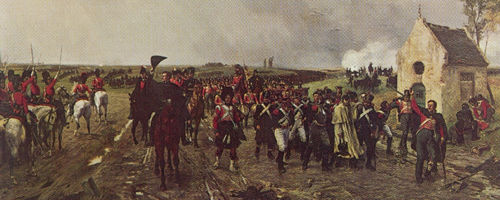
Wellington, seen here at Quatre Bras alongside his retreating troops and French prisoners, fought an inconclusive meeting battle with the French on the 16th June. His army had to fall back towards Brussels during a torrential summer storm, to maintain contact with the Prussians, on his left flank. [Ernst Croft]
The decade 1810 to 1819 had been the coldest since the 1690s. Meteorological records indicate that June 1815 was the wettest month of the year in England. The log books of the English Channel Fleet at Ostend record the violent summer storm that occurred on 17th/18th June and notes that it was followed by drier conditions after a wet start to the day.
Professor Laurent Bock from the University of Gembloux recently conducted a soil survey at Waterloo, which showed the soil on Wellington’s ridge would have become firm quite quickly. French positions down in the valley where Ney’s cavalry formed up would have remained waterlogged. Soil conditions favoured Wellington’s defence. If Napoleon had waited, it would have taken three or four days for the ground to dry out. Delaying for a few hours made little difference, the field remained a quagmire.
Victor Hugo argued that Divine intervention caused Napoleon’s downfall, claiming in his novel Les Misérables that `had it not rained on the night of the 17th/18th June 1815, the future of Europe would have been different’. The point is often made that Napoleon delayed the start of the battle because the wet ground impeded the movement forward of the Grand Battery’s potential battle-winning heavy 12-pounders. Delay provided time for the Prussian army to unite with Wellington and inflict the critical blow just when the outcome of the battle was delicately balanced.
Rain the night before meant muskets had to be `boiled out’ with hot water to remove residual powder and carbon deposits. This, and physical discomfort verging on exposure for tired soldiers, affected both armies. The summer storm cloaked the retreat of the Allied armies during the night before Waterloo. Mud was to impede the deployment of artillery and cavalry on both sides the next day. It did nullify the impact of Napoleon’s artillery superiority, reducing the bounce of round-shot on the soft ground, but Wellington’s decision to deploy behind the Mont St Jean ridgeline probably did most to reduce the vulnerability of troops to cannon fire. Napoleon’s army took a long time to form up, but delays were caused just as much by poor march discipline and the need to forage locally for food that morning than muddy conditions. Only the Imperial Guard had its own integral logistic wagon train. Nor was Napoleon galvanised by any knowledge that the Prussians were already marching to Wellington’s assistance.
The primary impact of the weather on this battle was that the hot afternoon following the wet cold night produced atmospheric conditions that added to battlefield obscuration through mist and hanging smoke. By midafternoon Napoleon could not see into the valley. This might have influenced the premature release of the French cavalry, which was to confront solid infantry squares instead of the retreat that Marshal Ney was convinced he saw happening through the smoke beyond the ridgeline. Napoleon could not see how weak Wellington’s centre was when La Haye-Sainte fell and neither could he probably encompass the true extent of Prussian numbers entering the field. In short, the vagaries of the weather impacted on both sides but likely favoured Wellington’s intrinsic advantage of holding the high ground in defence; a less vulnerable option and tactically far less demanding than the French need to attack.